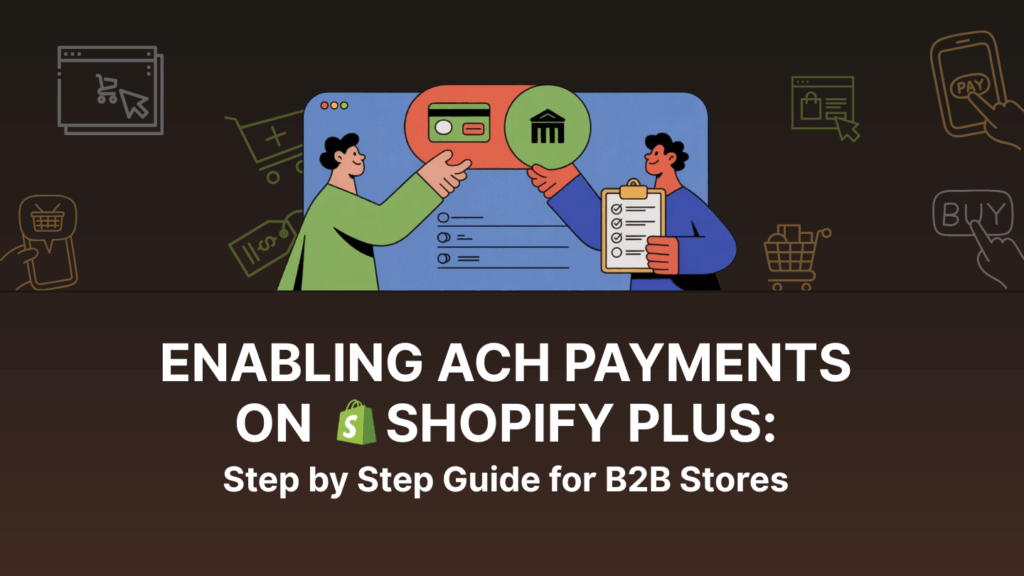Why B2B Approvals Are the Hidden Killer of Ecommerce Adoption
Picture this, a requisitioner at a construction company logs into your Shopify B2B portal. They’ve built a $42,000 order for equipment their site needs next month. They click submit and breathe a sigh of relief — job done. Except it isn’t.
That order doesn’t ship until it passes three layers of approvals: the department head, finance, and the supply chain manager. In theory, it should move smoothly. In reality, it lands in someone’s inbox and sits there. The manager is traveling. Finance wants to see backup documentation. No one knows who has the order, and days tick by while the project schedule tightens.
Meanwhile, the requisitioner loses faith in the portal. They send an email to their rep instead. The rep, pulled away from selling, spends hours chasing signatures manually just to keep the deal alive. The portal, the one built to save time and automate purchasing, has quietly become another bottleneck.
This is the failure point most B2B ecommerce projects never talk about. Not search, not checkout, not even payment terms. Approvals. The one step that makes or breaks whether procurement officers trust your portal enough to use it.
Shopify and BigCommerce are strong platforms. They can handle catalogs, pricing tiers, and even bulk orders. But if they can’t mirror a buyer’s approval hierarchy, adoption dies. Because in B2B, “click to buy” isn’t the workflow. “Click to approve” is.
The Reality of Multi-Level Approvals in B2B
An order in B2B is never just an order. It’s a request that has to wind its way through layers of responsibility before anything moves.
It usually starts with the person closest to the need—a plant supervisor, a project manager, or a requisitioner in procurement. They know what’s required on the ground, so they build the order. But their signature alone isn’t enough. The department head needs to check the budget. Finance has to validate the spend against terms and cash flow. Sometimes legal or supply chain gets pulled in if the order touches contracts or delivery schedules. By the time it’s done, the “simple” order may have passed through three or four different desks.
The logic is sound. Nobody wants a junior buyer spending $50,000 without oversight, and nobody wants to risk fraud or budget overruns. But in reality, this structure creates its own problems. An order that should move in a day can sit for a week because one approver is traveling. A requisitioner submits an order and then hears nothing for days, unsure if it’s stuck with a manager or if finance kicked it back. Everyone is waiting, nobody is sure where the order is, and projects stall while the approval limbo drags on.
This isn’t a rare edge case. It’s the daily rhythm in most organizations that deal with significant spending. And it’s exactly why procurement teams hesitate to adopt e-commerce portals. If the system can’t reflect this approval chain—if it treats every order as though one click is all it takes—it fails them. Because in B2B, the process isn’t about clicking “buy.” It’s about moving smoothly from request to approval to release without losing momentum.
Manage Approval Processes Before You Automate
Here’s how it usually plays out.
A requisitioner builds an order and submits it. They assume it’s moving. A week later, nothing has shipped. They start making calls and quickly realize the order never made it past their manager’s inbox. The manager had every intention of signing, but they were traveling and buried in other work. Now the requisitioner is frustrated, the project is behind schedule, and everyone is pointing fingers.
On the supplier’s side, the sales rep gets dragged back into the mess. Instead of closing new business, they’re emailing finance teams, leaving voicemails for approvers, and trying to figure out who exactly is holding the order. What was supposed to be an automated, buyer-driven process turns into a scavenger hunt for approvals.
The damage isn’t just lost time. Relationships start to fray. The buyer’s team feels like the supplier’s system doesn’t fit the way they work. They stop trusting it. And when trust slips, buyers default back to what’s safe: emailing a PO directly or skipping the portal entirely. Suddenly the e-commerce channel that was supposed to reduce friction is being bypassed altogether.
That’s when margins start bleeding too. To calm an annoyed customer, sales will often throw in a discount or rush an order at their own expense. Multiply that across accounts, and what looked like a tech hiccup becomes a financial drain.
The unspoken truth in B2B is this: approval delays don’t just stall orders. They erode confidence. And once a procurement officer feels like your system slows them down instead of helping them, they won’t give it another chance.
For the requisitioner, that failure is a risk to their credibility. Their team is waiting, deadlines are slipping, and they’re the one answering for delays they can’t control. Finance feels the same pressure from the other side, blamed for being the bottleneck even when the process is the real culprit. When approvals stall, it isn’t just the system that takes the hit—it’s the people inside it.
Why Shopify B2B Doesn’t Solve This Out of the Box
Shopify wasn’t built with procurement chains in mind. At its core, it’s an incredibly powerful e-commerce engine, but one designed around the idea that the person who clicks “checkout” is also the one who can approve the spend. That assumption works fine for simple transactions. It collapses the moment you step into a business where a $40,000 order has to touch three different desks before it moves.
Even Shopify Plus with its B2B features only scratches the surface. You can set up company accounts, buyer roles, and customer groups, but true multi-step approval chains aren’t supported out of the box. Those require customization or third-party workflow apps to mirror how real procurement hierarchies work. But those rules don’t stretch far enough for the real world. They don’t capture a requisitioner who can submit but not approve. They don’t cascade an order up through multiple managers, then over to finance, then finally to procurement leadership. They don’t show everyone where the order is stuck or why.
And so what happens? Buyers revert to email. A requisitioner builds the cart online but downloads it into a PDF, attaches it to an email, and pushes it through their old approval chain. By the time it comes back to you as a purchase order, the “ecommerce system” has been reduced to a glorified catalog.
It’s not that Shopify can’t handle approvals. It’s that it doesn’t handle them out of the box. Without customization, without building workflows that mirror how real companies make decisions, the portal will never feel trustworthy to the people using it. And if it doesn’t feel trustworthy, procurement won’t risk running critical orders through it.
This is the blind spot that sinks so many B2B ecommerce projects. The storefront looks slick. The catalog is clean. But the second an order hits the approval wall, everything backs up and the whole investment gets bypassed in favor of email and spreadsheets.
The Blueprint for Automated Multi-Level Approvals
If procurement officers are going to trust your Shopify portal, the approval process has to feel as natural as the way they already work, only faster. That means automation that respects the chain of command, not a shortcut that pretends it doesn’t exist.
An order starts with the requisitioner. They fill the cart, hit submit, and with the right customization—via Shopify Flow, APIs, or middleware—the system can automatically route it to the next approver instead of disappearing into a void. The department manager gets a notification—in their inbox, in the portal, wherever they are during the day. They click approve or reject with one action. No chasing, no wondering.
Once the manager signs off, the order doesn’t sit there waiting for someone to remember it. The system automatically routes it to finance. Finance sees the same order, with the manager’s approval already logged, and they have their own click-to-approve step. If compliance or procurement leadership needs to weigh in, the order flows to them automatically.
At every stage, the order is visible. The requisitioner can log in and see exactly who has it and what stage it’s in. The sales rep can see it too—no guessing, no “let me check and get back to you.” Everyone knows where the order is in the chain and how close it is to release.
The power of this blueprint isn’t just speed—it’s clarity. No one is stuck wondering, “Did my order get lost? Did my manager even see it? Is finance sitting on it?” The answer is always in the system, live, where everyone can see it.
When approvals move like this, automatically, click by click, flowing through the hierarchy without manual babysitting, orders stop dying in inboxes. They move. And when they move, trust builds. Procurement stops hedging, sales stops firefighting, and the portal finally becomes what it was meant to be: the smoothest path to buy.
Integration With ERP and Existing Procurement Systems
Here’s the part nobody likes to admit: approvals mean nothing if they don’t show up where the rest of the business is looking.
We’ve seen it too many times. A manager approves a six-figure order in the storefront, the requisitioner thinks it’s cleared, and then finance looks at their ERP and says, “We don’t see it.” Suddenly, everyone’s panicking. Operations hasn’t allocated the materials, the budget report is already outdated, and the buyer is on the phone asking why their order hasn’t moved. The portal didn’t fail because the approval wasn’t given; it failed because the approval was invisible everywhere else.
When approvals live only in Shopify without integration, they become siloed. The moment there’s a gap between the storefront and the ERP, trust starts to unravel because buyers and finance teams are no longer looking at the same data. And the moment there’s a gap between the storefront and the ERP, trust unravels. Procurement officers are already cautious; the second they see mismatched systems, they stop believing in the process.
Now picture the opposite. The manager approves it in Shopify, and at the same moment finance sees it logged in the ERP. Inventory is flagged as reserved. Compliance has the approval trail ready for audits. Everyone is looking at the same screen, no matter which system they’re in. Nobody’s chasing screenshots or emails. Nobody’s wondering, “Who dropped the ball?”
That’s what integration does: it turns approvals from a nice-to-have feature into something solid enough to carry contracts. Without it, the portal is just a catalog with extra steps. With it, it becomes the one place everyone trusts, because it connects to the backbone systems that already run the business.
And here’s why it matters even more: contracts depend on it. In industries where late deliveries trigger penalties or compliance audits, a broken approval trail isn’t just inefficient — it’s dangerous. A single missing sign-off can expose the supplier to disputes, write-offs, or even lost accounts. Integrated approvals protect more than workflow; they protect revenue and trust at the same time.
Beyond Speed: The Trust Buyers Remember
When approvals finally move the way they should, the impact isn’t just faster orders—it’s people breathing easier. A sales director doesn’t spend her Thursday nights chasing down signatures; she spends them building the next account. A CFO doesn’t worry that oversight has been traded for convenience; they see approvals logged in real time, right inside the ERP they trust. And the requisitioner, the person who used to feel powerless as projects slipped, can finally open the portal and know exactly where things stand.
The hidden costs that once bled through the cracks—discounts offered to calm frustration, last-minute rush fees, wasted hours in email limbo—start to vanish. In their place, something more valuable takes hold: confidence. Buyers begin to trust that every order will move the same way every time, without them having to beg, chase, or hedge. That trust is what sticks. Even when a competitor comes in cheaper, procurement officers remember who kept their projects moving and who left them waiting.
And it doesn’t stop at today’s problem. Once the backbone is in place, approvals can evolve. Low-risk orders can glide through on AI-driven fast tracks. Managers on the road can clear bottlenecks with a single tap from their phone. Finance can pull an audit trail without sending a single email. The process stops being fragile and starts being future-proof.
That’s the real transformation. Not just velocity, but a system buyers can believe in—and belief is what turns transactions into long-term partnerships.
Business Impact: From Bottleneck to Velocity
When approvals flow the old way, by email, by PDF, or by somebody walking a paper form across the office, orders don’t just slow down. They stall. A requisitioner waits, and a manager forgets. Finance pushes it to next week’s batch. Projects slip while everyone argues about who had it last.
The toll isn’t only on timelines. Sales reps get pulled back into babysitting. Instead of chasing new accounts, they’re chasing signatures. Procurement officers lose confidence and stop using the portal. And leadership starts asking why the ecommerce channel they invested in isn’t delivering the numbers.
But once approvals are automated, really automated, with clear routing and integration, the whole rhythm changes. Orders that used to linger for days move in hours. A requisitioner can see the exact stage: the manager signed off at 2:43 p.m., finance approved at 4:07, and procurement leadership is pending. No mystery or no guessing. Everyone involved knows the order is alive and moving.
For sales, the shift is immediate. They stop apologizing for delays they can’t control. They stop being middlemen. Their time goes back to building relationships and growing revenue.
For procurement, it feels like a weight lifted. They don’t have to nag approvers or check status in three different systems. The portal gives them the truth, live, and they can plan around it with confidence.
And for the supplier, it means trust. When buyers see that your system respects their hierarchy and keeps projects on schedule, they stick with you. They renew contracts. They move more business your way. Because in B2B, reliability isn’t just about the product you ship. It’s about the process that gets it approved and delivered without chaos.
What used to be a bottleneck becomes velocity. And that velocity doesn’t just smooth operations, it becomes your competitive edge.
Automating Multi-Level Approvals in Shopify B2B
Run through this toolkit as a working guide with your sales, IT, and procurement-facing teams before attempting automation. It will help you capture the messy reality of your customer approval chains and translate it into Shopify workflows that buyers actually trust.
Approval Workflow Audit Checklist
Map what really happens today before building anything new.
☐ Do we know who starts an order (requisitioner, plant supervisor, or site manager)?
☐ Do we know every approver in sequence (manager → finance → procurement leadership)?
☐ Do we understand what each approver looks for (budget match, documentation, compliance)?
☐ Do requisitioners and reps currently know where orders stall?
☐ Is there a recorded approval trail today, or is it buried in emails/PDFs?
Shopify Approval Build Scorecard
Translate approval logic into Shopify with Flow, APIs, or middleware.
| Requirement | Why It Matters | Shopify Approach | Status |
| Requisitioner can submit but not approve | Matches real procurement roles | Buyer Roles and custom Flow trigger | ☐ |
| Multi-step routing | Prevents bottlenecks in inboxes | API/middleware workflow | ☐ |
| Live status visible to requisitioner & sales | Builds trust and reduces calls | Order notes and custom portal view | ☐ |
| Notifications at each step | Keeps orders moving, avoids “lost in inbox” | Email/Slack/MS Teams alerts | ☐ |
| Approval log synced with ERP | Ensures finance & ops see the same truth | ERP connector/API push | ☐ |
Integration Readiness Questions
If the ERP doesn’t see the approval, the approval didn’t happen.
- Does your ERP/MRP mirror approvals from Shopify instantly?
- Will finance see approvals in their own system without extra logins?
- Can procurement pull an audit trail from ERP if contracts are challenged?
- Do inventory allocations trigger only after finance approves?
Success Metrics Dashboard
Track whether automation is protecting contracts and margins.
| Metric | Baseline | Target (90 days) |
| Average approval cycle time | ___ days | ↓ 50% |
| % of orders stalled >3 days | ___ % | < 10% |
| % of orders bypassing portal (via email/PO) | ___ % | < 15% |
| Sales rep time spent chasing approvals | ___ hrs/month | ↓ 60% |
| Buyer satisfaction / adoption rate | ___ % | > 80% |
If a buyer can log into your Shopify portal, build an order, and watch it pass through every approver without making a single phone call, you’ve succeeded. Anything less, and procurement will quietly go back to email.
From Chaos to Final Approval
Every supplier knows the pain of a stalled order. The requisitioner insists they submitted it. The manager swears they’ll get to it. Finance hasn’t even opened the file. Weeks slip away, projects stall, and what should have been a clean process turns into a mess of calls, emails, and frustration.
That’s why multi-level approvals aren’t a detail to tack on later. They’re the backbone of whether your Shopify B2B portal earns trust. Without them, procurement will never rely on the system. With them—automated, transparent, integrated—your portal stops being a catalog and becomes a procurement tool that accelerates business instead of slowing it down.
If your buyers are still chasing signatures over email or waiting days to find out who has their order, your portal isn’t ready for serious B2B. And the risk isn’t just inefficiency; it’s lost confidence, lost contracts, and lost revenue.
Contact us, we’ll show you where they break and build the automation that makes those chains click-to-approve inside Shopify platform.
Because in B2B, contracts live or die in the approval chain. Get it right, and the bottleneck disappears. Get it wrong, and the portal you built becomes the one your customers quietly avoid.










